
The possibility of Pope Francis' retirement based on the aging pontiff's statement following his Canadian trip has sent shock waves across the Catholic sphere.
After his return to the Vatican from his six-day tour of Canada, Pope Francis has hinted anew at the possibility of him no longer being a pope.
News reports at the time of his Canadian 'penitential pilgrimage' showed the 85-year-old pontiff on a cane, walker, and wheelchair as he visited several sites and attended events.
The Holy Father remarked that his trip there made him realize that he must slow down due to his knee problems.
He added that he is 'keeping his doors open' to the possibility of stepping down from his position as head of the world's 1.6 billion Catholics.
With Pope Francis' retirement possibly nearing, it's worth discussing how things would unfold based on established rules and precedence, such as then-Pope Benedict XVI's retirement.
How would the College of Cardinals, which is composed of cardinal-electors, choose the next pope if Francis decides to retire his post?
Here are a few things you need to know about the process of choosing the next pope:
1. The cardinal camerlengo takes up residence at the Vatican Palace. The camerlengo represents the College of Cardinals and is the one tasked to kickstart the search for a new pope. Be it due to death or abdication/resignation, the camerlengo determines and declares the termination of a pope's reign.
To signify this phase, the camerlengo breaks both the pope's papal seal and Fisherman's Ring, which effectively culminates the pope's authority as head of the Church.
2. The papal conclave begins. Following the end of the pope's authority, the camerlengo summons all cardinal electors to the Vatican to officially start the conclave. Every cardinal elector's sacred duty is to participate in the conclave. Still, a cardinal elector may opt not to join for meritorious reasons, such as ill health.
3. The cardinal electors reside at the Domus Sanctae Marthae. The official residence of the cardinal electors is called the Domus Sanctae Marthae. At this residence, the cardinal electors stay until the end of the conclave.
The residence is tightly guarded, and the electors are prohibited from accessing any electronic device or news content. Also, only individuals with a direct business concerning the conclave are allowed in and out of the cardinal electors' residence.
4. The secret balloting commences. The cardinal electors are each given a ballot on which they discreetly write their choice for the next pope. The balloting happens within the Sistine Chapel.
There is a single ballot on the inaugural day of the conclave. If no pope is elected on the first day, the cardinal electors participate in four ballots (two each in the morning and afternoon) during the succeeding days until a pope is elected.
5. The color of smoke coming out of the Sistine Chapel's roof signifies the outcome/s of the balloting. Catholics "watching" the conclave from outside traditionally rely on the color of the smoke coming out of the Sistine Chapel to determine the progress of the papal conclave. If the smoke is black, no papabile has received the required majority vote; if it is white, a new pope has been elected.
In recent times, the white smoke has been accompanied by the ringing of bells in St. Peter's Basilica to ensure that the announcement is both seen and heard.
6. The Dean of the cardinals asks the elected pope for his acceptance of the papacy. Once the balloting has elected a pope, the College of Cardinal's Dean asks the new pope if he accepts his position as head of the Catholic Church.
7. The new pope chooses his name. The Dean will also ask the new pope about the name he wishes to assume (such as John Paul II, Benedict XVI, or Francis II). The pope will cease to use his old name and take the new name throughout his papacy and even until his death or retirement.
8. The senior cardinal deacon announces the election of a new pope. Once the new pope has accepted his papacy and chosen his new name, the senior cardinal deacon walks toward the central balcony and exclaims, "Habemus papam!" This translates to "We have a pope."
9. The new pope addresses the crowd in papal regalia. It is the first time the Catholic faithful who held a vigil at Vatican Square catches a glimpse of their new leader.
10. The new pope disbands the conclave. The newly-elected pope addresses the College of Cardinals and declares the conclave over.
11. The installation of the new pope is held. Following the disbanding of the papal conclave, the new pope is formally installed as the head of the Catholic Church until his death or retirement.
While Pope Francis' retirement may not happen soon, it's important to know how the selection process for his successor would go.
For many, this is enough to quell any uncertainty over the fate of the Church, knowing that a system is in place to elect a new pope in the fastest and smoothest ways possible.
Related Article: Potential Papal Contender Cardinal Luis Tagle Highlights I Peter's Letter to Early Christians at 15th Lambeth Conference



















